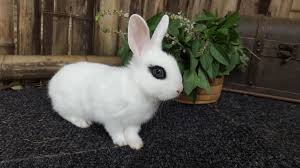
Dwarf Hotot
Conditions of detention
Requires a small to medium-sized cage with soft bedding and a secure enclosure
Useful Fact: Dwarf Hotots are very active and need time outside their cage for exercise
Nutrition and diet
Primarily hay, with a small portion of pellets and fresh greens
Useful Fact: Monitor their diet closely to avoid obesity, which they can be prone to
Health
Prone to dental issues due to their small size and respiratory problems
Useful Fact: Regular check-ups with a vet can help catch and prevent health issues early
Grooming and care
Requires regular brushing, especially during shedding seasons, to maintain their coat
Useful Fact: Check their eyes regularly for any discharge, as they are prone to eye problems
Education and training
Can be litter-trained and responds well to positive reinforcement
Useful Fact: Start training early to build a strong bond and establish good habits
Toys and entertainment
Enjoys small chew toys, tunnels, and climbing structures
Useful Fact: Providing different textures and materials for chewing helps keep them entertained and prevents boredom
Safety
Keep their environment free from small objects and ensure their cage is secure to prevent escapes
Useful Fact: Due to their small size, they are more vulnerable to injury, so handle them gently
Accessories
A litter box, chew toys, and a comfortable sleeping area
Useful Fact: Provide a small hideaway where they can retreat if they feel threatened or stressed
Socialization
Generally friendly and enjoys human interaction but can be shy at first
Useful Fact: Regular gentle handling helps them become more social and trusting
Travel and Transportation
Use a small, secure carrier with soft bedding and familiar scents
Useful Fact: Keep travel short and avoid sudden movements to minimize stress
Behavior and psychology
Typically calm and friendly but may be cautious around strangers
Useful Fact: Establishing a routine can help reduce stress and keep them happy
Legal aspects
No special requirements for ownership, but always check local regulations for breeding
Useful Fact: Purchase from reputable breeders to avoid issues with inbreeding or poor health


